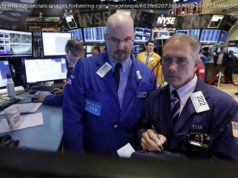Big victims: real estate, farmers, and anyone with a lot of leverage.
Will Trump back down from his urge to start a trade war? Nobody knows; the thing is, he’s been an ignorant trade hawk for decades, he’s feeling beleaguered on many fronts, and word is that his doctor has told him to eat fewer burgers. So there’s surely a lot of pent-up rage that he’s all too likely to take out on the world trading system, especially when he tweets stuff like this:
So it’s worth asking what would happen if Trump really did try to close the trade gap – it’s actually $500 billion, not $800 billion, but who’s counting – by imposing tariffs.
The trade gap is currently running a bit shy of 3 percent of GDP, while imports are 15 percent of GDP:
If the price elasticity of import demand is around 1, which is a typical estimate for the short-to-medium run, a 20 percent across the board tariff might, other things equal, be enough to close the gap. But other things would very much not be equal.
Leave aside the issue of foreign retaliation/emulation, although that would be a very big deal in practice. Assume instead that the U. S. gets away with it, with no foreign response. Even so, this wouldn’t work out the way Trump imagines.
You see, diverting demand equal to 3 percent of GDP from foreign to domestic products would not increase US output by 3 percent relative to what it would have been otherwise, let alone the 4.5 percent you’d expect if there’s a multiplier effect. Why? Because the US is close to full employment. Maybe – maybe – we have another half-point of unemployment to go. But a 3 percent rise in output relative to trend would reduce unemployment about 3 times that much, 1.5 percentage points. And that just isn’t going to happen.
What would happen instead is that the Fed would raise rates sharply to head off inflationary pressures (especially because a 20 percent tariff would directly raise prices by something like 3 percent.) The rise in interest rates would have two big effects. First, it would squeeze interest-sensitive sectors: Trump’s friends in real estate would become very, very unhappy, as would anyone who is highly leveraged (hello, Jared.)






